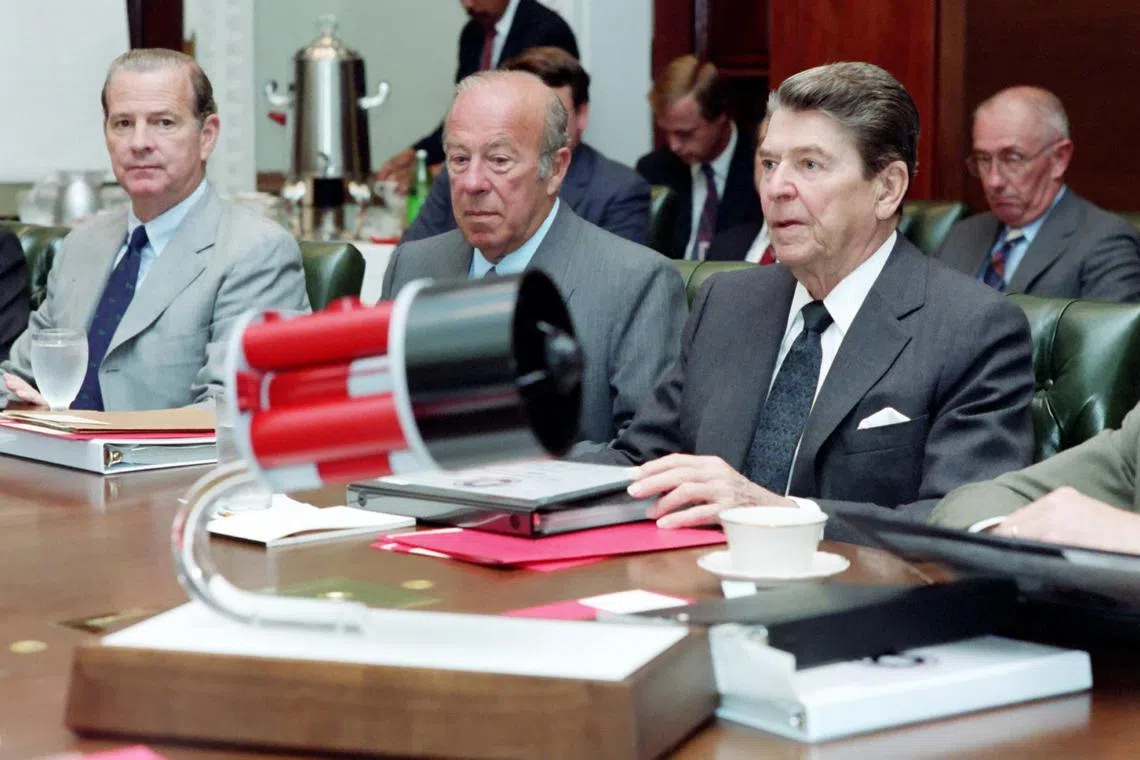Reagan's 'Star Wars' at 40: Battle of the satellites
Sign up now: Get ST's newsletters delivered to your inbox

Former US president Ronald Reagan Ronald Reagan’s (right) vision of space as a battle theatre did materialise.
PHOTO: THE RONALD REAGAN PRESIDENTIAL FOUNDATION AND INSTITUTE/FACEBOOK
Follow topic:
WASHINGTON - Forty years after former United States president Ronald Reagan stunned the nation and world with his “Star Wars” plan to take nuclear competition into outer space, a new battle of the satellites has emerged in the stratosphere.
Largely because it far outpaced technology at the time, very little became of Mr Reagan’s March 23, 1983, declaration that the US would head to space to seek absolute supremacy in the Cold War with the Soviet Union.
Nevertheless, space ultimately has become a major theatre of strategic competition – just not the way Mr Reagan envisioned.
Instead of missiles launched from orbit to attack rivals, thousands of satellites are now the focus of sometimes tense dynamics between the US, Soviet Union successor Russia, and China.
Also defying Mr Reagan’s vision, the US does not have any clear advantage: China especially is showing its ability to match or even lead the US.
‘Hope for our children’
Mr Reagan’s programme was officially the Strategic Defence Initiative (SDI).
But it immediately became known as Star Wars, for its evocation of Hollywood sci-fi visions of fantastic weaponry beaming through the cosmos.
That was where America’s technological prowess would dominate, Mr Reagan declared.
“I’ve reached a decision which offers a new hope for our children in the 21st century,” he said, in language echoing the 1977 “Star Wars” film, subtitled “A New Hope”.
Global security will no longer rest on the principle that neither the US nor the Soviets could survive a nuclear exchange – the so-called mutual assured destruction (MAD) doctrine, he said.
Instead, American technology will produce space weapons to instantly pulverise any Soviet nuclear missiles launched at the US.
“We maintain the peace through our strength; weakness only invites aggression,” Mr Reagan said.
Satellite wars
Billions of dollars went into SDI, to develop space-based laser and particle-beam weapons and launchers for ballistic missile-destroying rockets.
But his ideas were unfeasible; the technology did not exist.
A decade later, Star Wars disappeared, quietly folded into a more conventional nuclear deterrent programme: ground-based missile defence.
Today, with Russia menacing Ukraine with nuclear weapons and China accelerating production of missiles and warheads, MAD remains the main reason nuclear war has not broken out.
Yet Mr Reagan’s vision of space as a battle theatre did materialise.
Today, orbiting satellites are crucial tools of war – and as the electronic backbone of ground-based conflict they are also the primary targets.
Back in 1983, satellites were large and hugely expensive; only about 360 were in orbit.
Now, according to the UN Office for Outer Space Affairs, there are 9,312 circling above us.
About 2,700 went into orbit last year alone, according to Euroconsult.
Many are small, cheap and operate in networks for civilian communications, research and business use.
But hundreds, if not thousands, are military and intelligence units.
Some are launched as mini-satellite networks to provide early warning for ballistic missile launches.
Space stalkers
But they do not just conduct surveillance.
Washington, Moscow and Beijing have developed “space stalker” satellites that can be manipulated to physically interfere with others.
With robotic arms and grappling claws, “they can just stalk the opponent satellite and move it somewhere else, or bend an antenna” to render it useless, according to Mr Brian Chow, an independent space policy analyst.
Experts say satellites under development will have weapons that can shoot rival units or send explosive charges to blow them up.
In addition, China and the US both have ultra-secret programmes of small, reusable, robotic, winged spacecraft which could be armed to damage a rival’s satellites.
Meanwhile, the superpowers have abilities – which they regularly use – to jam and spoof satellite signals, doing so from both the ground and orbit.
All three countries have also demonstrated they can launch a missile from Earth that can destroy an orbiting satellite.
The Pentagon says China has ground-based laser stations that can interfere with if not disable satellites; presumably the US and Russia have, or are developing, similar capability.
One thing Mr Reagan did not envision was putting nuclear weapons in orbit. That was banned in the 1967 Outer Space Treaty, which most countries have joined.
But there have been few other limitations on space strife.
Last April, Washington took one baby step in this regard, hoping to bring Russia and China with them.
US Vice-President Kamala Harris said the US will renounce testing of ground-launched anti-satellite missiles, and urged rivals to do the same.
Such tests leave large amounts of dangerous debris circling the planet.
“Without clear norms, we face unnecessary risks in space,” Ms Harris said. AFP

